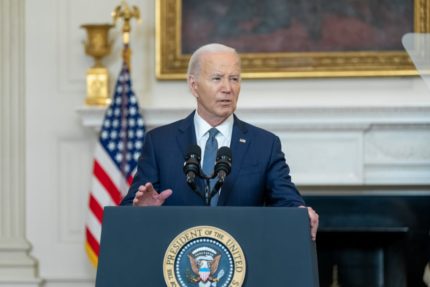A massive pro-Palestine demonstration in front of the White House turned chaotic on Saturday, with smoke bombs deployed and numerous attendees claiming they were maced. The protest, which attracted thousands of demonstrators, called for a ceasefire in Gaza. The scene quickly descended into disorder as smoke billowed in front of the White House, while a speaker vehemently condemned Israel as a “butcher of Gaza.”
Independent journalist Ford Fischer documented the escalating tension, sharing an image of his bloodshot face on social media, asserting that mace was used against the crowd during an attempted arrest. Video footage also showed police officers maneuvering through the dense crowd amidst chants of “Free Palestine” and “f*** the police.” This protest, marking eight months since the conflict began, saw activists travel from various states to join the rally.
Protestors Rally for Gaza Amid Heavy Security Measures
As the protest unfolded, the Secret Service implemented stringent security protocols, including the erection of anti-scale fencing around the White House. Demonstrators, determined to make their voices heard, unfurled a giant red banner bearing the names of victims, encircling the White House in a powerful display. Despite the chaos, the protesters remained resolute in their call for an immediate end to the violence in Gaza.
With President Biden on an official visit to France, the protest highlighted the intense emotions and urgent demands of those calling for a ceasefire. Roads surrounding Lafayette Square Park, including the 1600 block of H Street NW from 17th St NW, were shut down, emphasizing the scale and impact of the demonstration. The White House reiterated its stance, emphasizing its support for peaceful protests only, amidst the unfolding turmoil.
Gaza Conflict: A Catalyst for Global Protests
The protest at the White House is part of a larger wave of global demonstrations triggered by the ongoing conflict in Gaza. According to reports, over 36,000 Palestinians have lost their lives due to Israeli strikes since the conflict’s escalation following the Hamas attack on October 7, which resulted in 1,200 Israeli deaths. The staggering death toll and the continuous violence have sparked widespread outrage and calls for intervention.
Activists at the rally emphasized the urgent need for a ceasefire, reflecting the sentiments of many around the world who are demanding an end to the bloodshed. The demonstration in Washington, D.C., underscores the global dimensions of the conflict and the powerful mobilization of people advocating for peace and justice in Gaza. The use of smoke bombs and reports of mace only added to the volatility of an already charged atmosphere, highlighting the intense emotions and high stakes involved in the ongoing struggle.
Unrest over White House Middle East Policy Escalates
The US State Parks Department recently confirmed that no arrests have been made yet in connection to the ongoing pro-Palestinian protests. These demonstrations, which have spanned several months, have taken a variety of forms, from marches and vigils to more disruptive actions like blocking bridges and roads near key transportation hubs such as train stations and airports. In multiple cities, these protests have drawn significant attention and participation, reflecting a widespread and passionate support for the Palestinian cause.
On college campuses, encampments have been established as students and faculty join in solidarity, advocating for policy changes and greater awareness of Palestinian issues. These campus movements have been a notable aspect of the broader protest activities, highlighting the involvement of younger generations and the academic community in this global conversation.
Political Impact and Administration Resignations
The protests have also had significant political repercussions within the US. At least eight officials have resigned from President Joe Biden’s administration, citing their disagreement with his policies on the Israel-Palestine conflict. These resignations underscore a growing division within the administration and reflect broader public discontent with the current US stance on the issue.
Additionally, pro-Palestinian protesters have disrupted several of Biden’s reelection campaign events, signaling their intent to keep this issue at the forefront of national discourse. These disruptions have added pressure on the Biden administration to address the protesters’ concerns and have highlighted the increasing influence of grassroots movements on national politics. The ongoing protests and political resignations indicate a significant and persistent challenge for the Biden administration as it navigates both domestic and international pressures.














